Case Study Analysis: Wound Physiology, Contamination & Antibiotics
VerifiedAdded on 2023/06/05
|7
|1900
|488
Case Study
AI Summary
This case study analyzes a patient's wound, examining the physiological basis of observations such as redness, warmth, pain, swelling, and purulent discharge, linking them to inflammation and potential infection. It explores possible endogenous (skin bacteria like Staphylococci) and exogenous (contaminated handkerchief) sources of contamination and their transmission modes. The rationale behind using ceftriaxone (immediate IV dose), cephalexin (oral), and dicloxacillin (oral) is discussed, focusing on their mechanisms of action against bacterial cell wall synthesis and resistance. Adverse reactions to dicloxacillin, such as severe stomach pain and renal impairment, are also mentioned. Finally, the case study outlines the four stages of wound healing: hemostasis, inflammation, proliferation, and maturation, highlighting the importance of each phase in the recovery process. The document is available on Desklib, a platform providing study tools and resources for students.
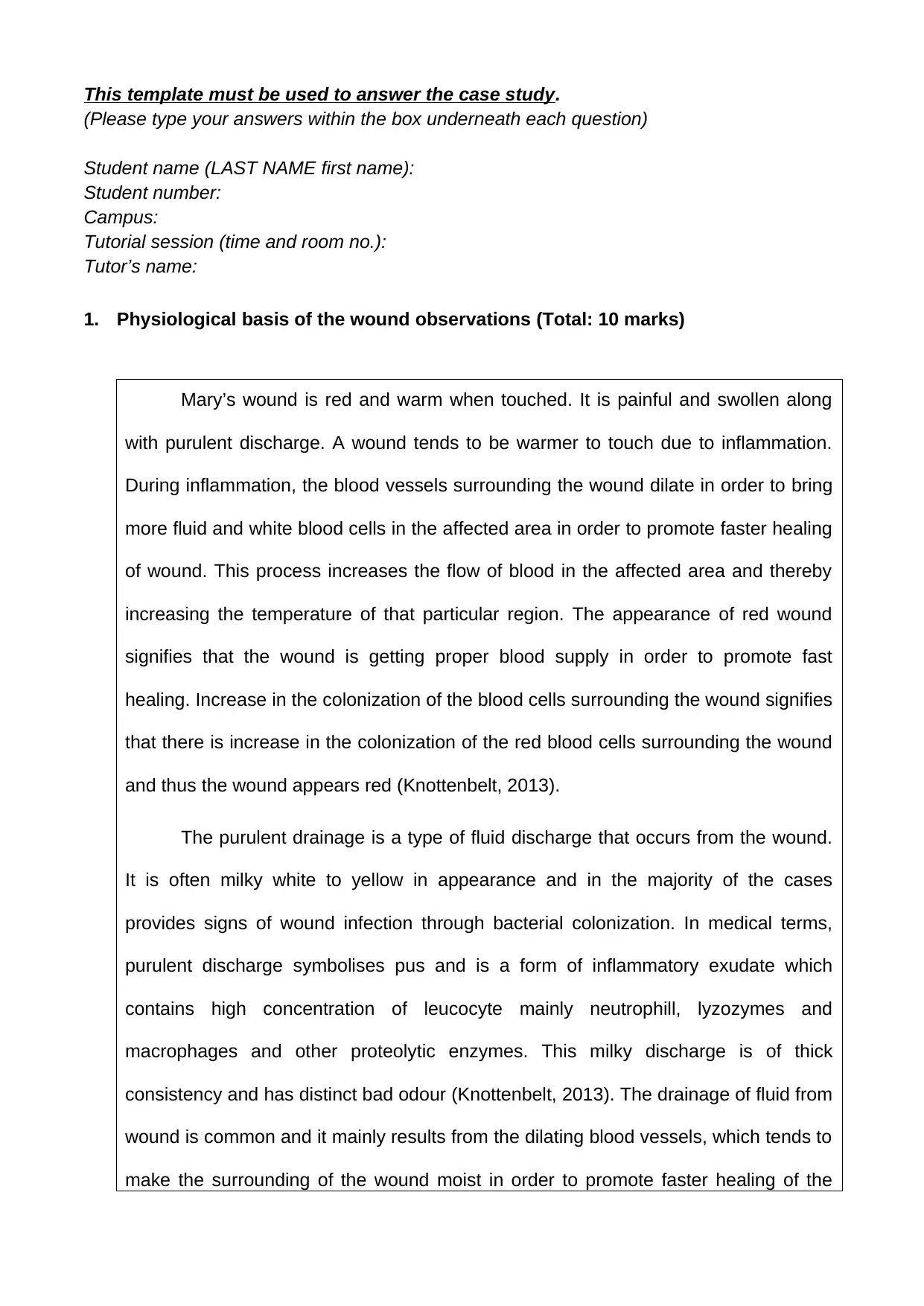
This template must be used to answer the case study.
(Please type your answers within the box underneath each question)
Student name (LAST NAME first name):
Student number:
Campus:
Tutorial session (time and room no.):
Tutor’s name:
1. Physiological basis of the wound observations (Total: 10 marks)
Mary’s wound is red and warm when touched. It is painful and swollen along
with purulent discharge. A wound tends to be warmer to touch due to inflammation.
During inflammation, the blood vessels surrounding the wound dilate in order to bring
more fluid and white blood cells in the affected area in order to promote faster healing
of wound. This process increases the flow of blood in the affected area and thereby
increasing the temperature of that particular region. The appearance of red wound
signifies that the wound is getting proper blood supply in order to promote fast
healing. Increase in the colonization of the blood cells surrounding the wound signifies
that there is increase in the colonization of the red blood cells surrounding the wound
and thus the wound appears red (Knottenbelt, 2013).
The purulent drainage is a type of fluid discharge that occurs from the wound.
It is often milky white to yellow in appearance and in the majority of the cases
provides signs of wound infection through bacterial colonization. In medical terms,
purulent discharge symbolises pus and is a form of inflammatory exudate which
contains high concentration of leucocyte mainly neutrophill, lyzozymes and
macrophages and other proteolytic enzymes. This milky discharge is of thick
consistency and has distinct bad odour (Knottenbelt, 2013). The drainage of fluid from
wound is common and it mainly results from the dilating blood vessels, which tends to
make the surrounding of the wound moist in order to promote faster healing of the
(Please type your answers within the box underneath each question)
Student name (LAST NAME first name):
Student number:
Campus:
Tutorial session (time and room no.):
Tutor’s name:
1. Physiological basis of the wound observations (Total: 10 marks)
Mary’s wound is red and warm when touched. It is painful and swollen along
with purulent discharge. A wound tends to be warmer to touch due to inflammation.
During inflammation, the blood vessels surrounding the wound dilate in order to bring
more fluid and white blood cells in the affected area in order to promote faster healing
of wound. This process increases the flow of blood in the affected area and thereby
increasing the temperature of that particular region. The appearance of red wound
signifies that the wound is getting proper blood supply in order to promote fast
healing. Increase in the colonization of the blood cells surrounding the wound signifies
that there is increase in the colonization of the red blood cells surrounding the wound
and thus the wound appears red (Knottenbelt, 2013).
The purulent drainage is a type of fluid discharge that occurs from the wound.
It is often milky white to yellow in appearance and in the majority of the cases
provides signs of wound infection through bacterial colonization. In medical terms,
purulent discharge symbolises pus and is a form of inflammatory exudate which
contains high concentration of leucocyte mainly neutrophill, lyzozymes and
macrophages and other proteolytic enzymes. This milky discharge is of thick
consistency and has distinct bad odour (Knottenbelt, 2013). The drainage of fluid from
wound is common and it mainly results from the dilating blood vessels, which tends to
make the surrounding of the wound moist in order to promote faster healing of the
Paraphrase This Document
Need a fresh take? Get an instant paraphrase of this document with our AI Paraphraser
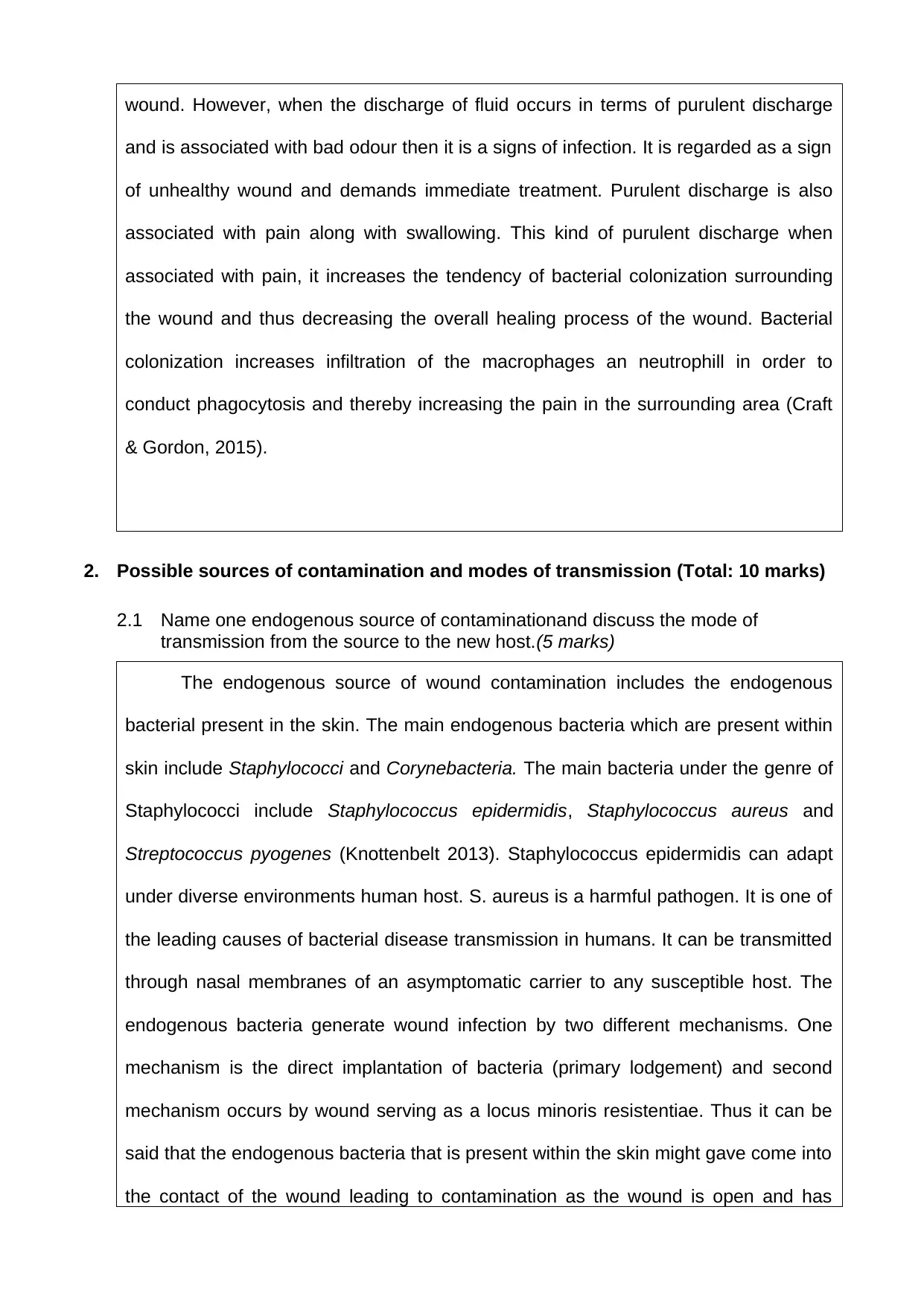
wound. However, when the discharge of fluid occurs in terms of purulent discharge
and is associated with bad odour then it is a signs of infection. It is regarded as a sign
of unhealthy wound and demands immediate treatment. Purulent discharge is also
associated with pain along with swallowing. This kind of purulent discharge when
associated with pain, it increases the tendency of bacterial colonization surrounding
the wound and thus decreasing the overall healing process of the wound. Bacterial
colonization increases infiltration of the macrophages an neutrophill in order to
conduct phagocytosis and thereby increasing the pain in the surrounding area (Craft
& Gordon, 2015).
2. Possible sources of contamination and modes of transmission (Total: 10 marks)
2.1 Name one endogenous source of contaminationand discuss the mode of
transmission from the source to the new host.(5 marks)
The endogenous source of wound contamination includes the endogenous
bacterial present in the skin. The main endogenous bacteria which are present within
skin include Staphylococci and Corynebacteria. The main bacteria under the genre of
Staphylococci include Staphylococcus epidermidis, Staphylococcus aureus and
Streptococcus pyogenes (Knottenbelt 2013). Staphylococcus epidermidis can adapt
under diverse environments human host. S. aureus is a harmful pathogen. It is one of
the leading causes of bacterial disease transmission in humans. It can be transmitted
through nasal membranes of an asymptomatic carrier to any susceptible host. The
endogenous bacteria generate wound infection by two different mechanisms. One
mechanism is the direct implantation of bacteria (primary lodgement) and second
mechanism occurs by wound serving as a locus minoris resistentiae. Thus it can be
said that the endogenous bacteria that is present within the skin might gave come into
the contact of the wound leading to contamination as the wound is open and has
and is associated with bad odour then it is a signs of infection. It is regarded as a sign
of unhealthy wound and demands immediate treatment. Purulent discharge is also
associated with pain along with swallowing. This kind of purulent discharge when
associated with pain, it increases the tendency of bacterial colonization surrounding
the wound and thus decreasing the overall healing process of the wound. Bacterial
colonization increases infiltration of the macrophages an neutrophill in order to
conduct phagocytosis and thereby increasing the pain in the surrounding area (Craft
& Gordon, 2015).
2. Possible sources of contamination and modes of transmission (Total: 10 marks)
2.1 Name one endogenous source of contaminationand discuss the mode of
transmission from the source to the new host.(5 marks)
The endogenous source of wound contamination includes the endogenous
bacterial present in the skin. The main endogenous bacteria which are present within
skin include Staphylococci and Corynebacteria. The main bacteria under the genre of
Staphylococci include Staphylococcus epidermidis, Staphylococcus aureus and
Streptococcus pyogenes (Knottenbelt 2013). Staphylococcus epidermidis can adapt
under diverse environments human host. S. aureus is a harmful pathogen. It is one of
the leading causes of bacterial disease transmission in humans. It can be transmitted
through nasal membranes of an asymptomatic carrier to any susceptible host. The
endogenous bacteria generate wound infection by two different mechanisms. One
mechanism is the direct implantation of bacteria (primary lodgement) and second
mechanism occurs by wound serving as a locus minoris resistentiae. Thus it can be
said that the endogenous bacteria that is present within the skin might gave come into
the contact of the wound leading to contamination as the wound is open and has
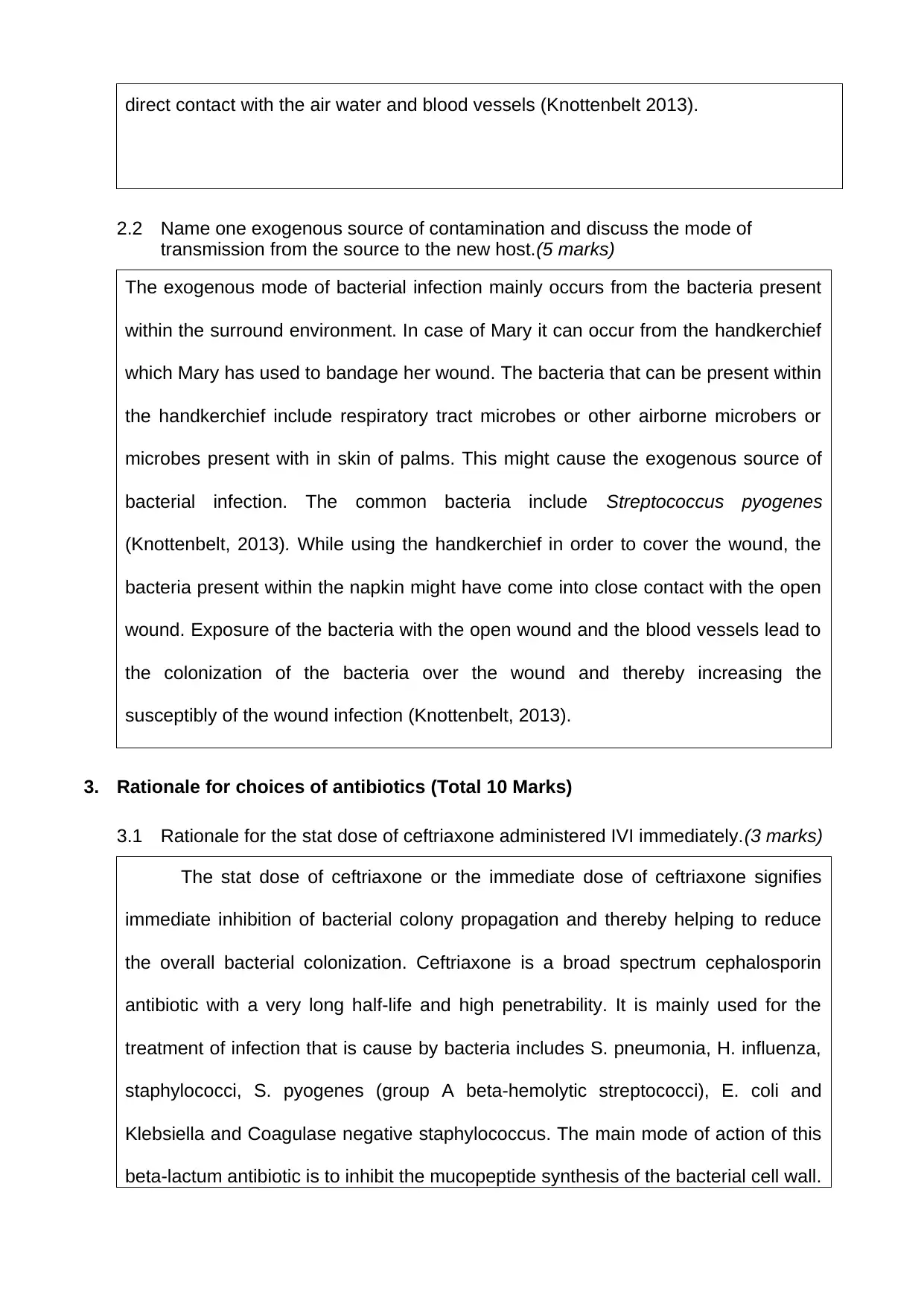
direct contact with the air water and blood vessels (Knottenbelt 2013).
2.2 Name one exogenous source of contamination and discuss the mode of
transmission from the source to the new host.(5 marks)
The exogenous mode of bacterial infection mainly occurs from the bacteria present
within the surround environment. In case of Mary it can occur from the handkerchief
which Mary has used to bandage her wound. The bacteria that can be present within
the handkerchief include respiratory tract microbes or other airborne microbers or
microbes present with in skin of palms. This might cause the exogenous source of
bacterial infection. The common bacteria include Streptococcus pyogenes
(Knottenbelt, 2013). While using the handkerchief in order to cover the wound, the
bacteria present within the napkin might have come into close contact with the open
wound. Exposure of the bacteria with the open wound and the blood vessels lead to
the colonization of the bacteria over the wound and thereby increasing the
susceptibly of the wound infection (Knottenbelt, 2013).
3. Rationale for choices of antibiotics (Total 10 Marks)
3.1 Rationale for the stat dose of ceftriaxone administered IVI immediately.(3 marks)
The stat dose of ceftriaxone or the immediate dose of ceftriaxone signifies
immediate inhibition of bacterial colony propagation and thereby helping to reduce
the overall bacterial colonization. Ceftriaxone is a broad spectrum cephalosporin
antibiotic with a very long half-life and high penetrability. It is mainly used for the
treatment of infection that is cause by bacteria includes S. pneumonia, H. influenza,
staphylococci, S. pyogenes (group A beta-hemolytic streptococci), E. coli and
Klebsiella and Coagulase negative staphylococcus. The main mode of action of this
beta-lactum antibiotic is to inhibit the mucopeptide synthesis of the bacterial cell wall.
2.2 Name one exogenous source of contamination and discuss the mode of
transmission from the source to the new host.(5 marks)
The exogenous mode of bacterial infection mainly occurs from the bacteria present
within the surround environment. In case of Mary it can occur from the handkerchief
which Mary has used to bandage her wound. The bacteria that can be present within
the handkerchief include respiratory tract microbes or other airborne microbers or
microbes present with in skin of palms. This might cause the exogenous source of
bacterial infection. The common bacteria include Streptococcus pyogenes
(Knottenbelt, 2013). While using the handkerchief in order to cover the wound, the
bacteria present within the napkin might have come into close contact with the open
wound. Exposure of the bacteria with the open wound and the blood vessels lead to
the colonization of the bacteria over the wound and thereby increasing the
susceptibly of the wound infection (Knottenbelt, 2013).
3. Rationale for choices of antibiotics (Total 10 Marks)
3.1 Rationale for the stat dose of ceftriaxone administered IVI immediately.(3 marks)
The stat dose of ceftriaxone or the immediate dose of ceftriaxone signifies
immediate inhibition of bacterial colony propagation and thereby helping to reduce
the overall bacterial colonization. Ceftriaxone is a broad spectrum cephalosporin
antibiotic with a very long half-life and high penetrability. It is mainly used for the
treatment of infection that is cause by bacteria includes S. pneumonia, H. influenza,
staphylococci, S. pyogenes (group A beta-hemolytic streptococci), E. coli and
Klebsiella and Coagulase negative staphylococcus. The main mode of action of this
beta-lactum antibiotic is to inhibit the mucopeptide synthesis of the bacterial cell wall.
⊘ This is a preview!⊘
Do you want full access?
Subscribe today to unlock all pages.

Trusted by 1+ million students worldwide
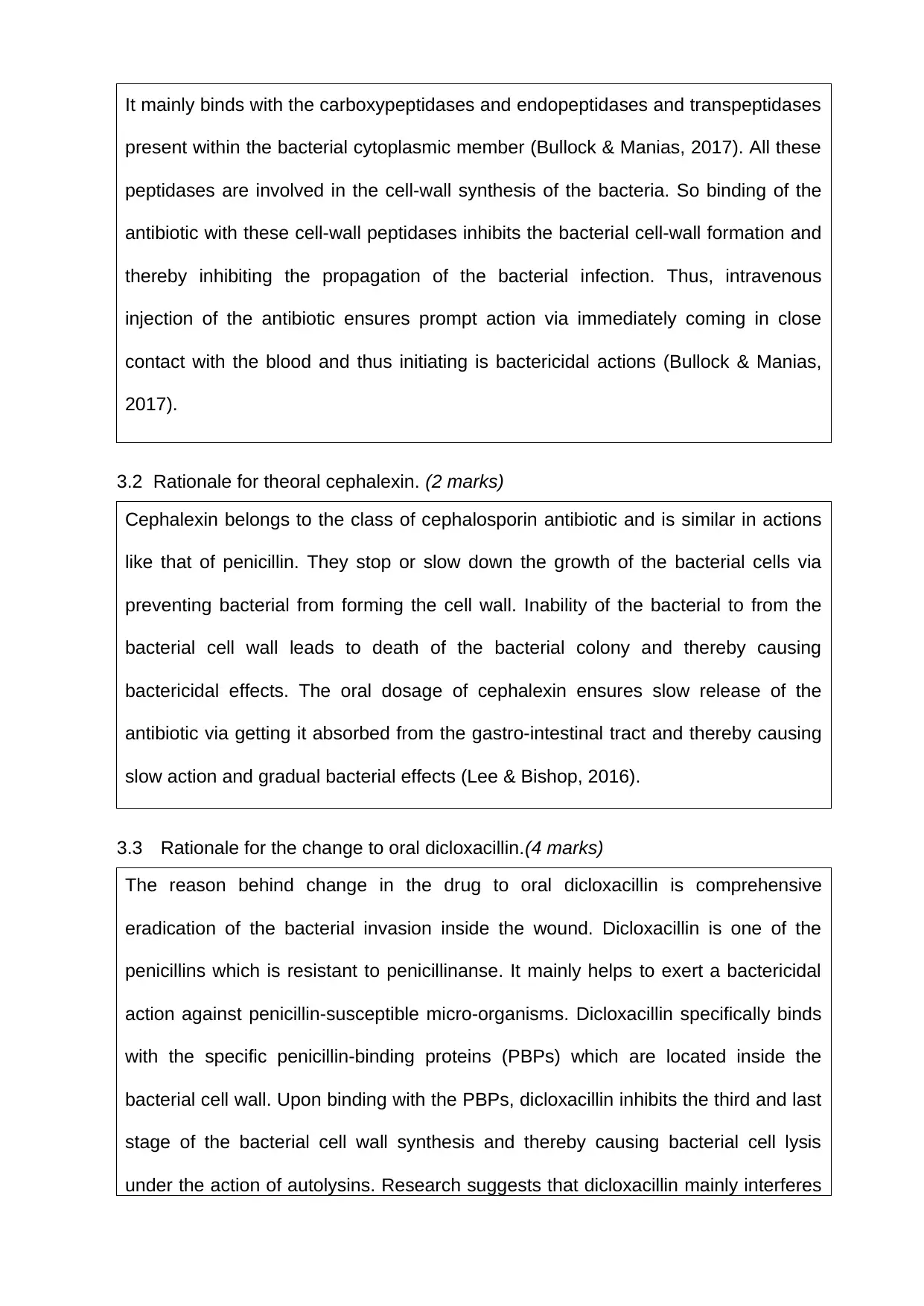
It mainly binds with the carboxypeptidases and endopeptidases and transpeptidases
present within the bacterial cytoplasmic member (Bullock & Manias, 2017). All these
peptidases are involved in the cell-wall synthesis of the bacteria. So binding of the
antibiotic with these cell-wall peptidases inhibits the bacterial cell-wall formation and
thereby inhibiting the propagation of the bacterial infection. Thus, intravenous
injection of the antibiotic ensures prompt action via immediately coming in close
contact with the blood and thus initiating is bactericidal actions (Bullock & Manias,
2017).
3.2 Rationale for theoral cephalexin. (2 marks)
Cephalexin belongs to the class of cephalosporin antibiotic and is similar in actions
like that of penicillin. They stop or slow down the growth of the bacterial cells via
preventing bacterial from forming the cell wall. Inability of the bacterial to from the
bacterial cell wall leads to death of the bacterial colony and thereby causing
bactericidal effects. The oral dosage of cephalexin ensures slow release of the
antibiotic via getting it absorbed from the gastro-intestinal tract and thereby causing
slow action and gradual bacterial effects (Lee & Bishop, 2016).
3.3 Rationale for the change to oral dicloxacillin.(4 marks)
The reason behind change in the drug to oral dicloxacillin is comprehensive
eradication of the bacterial invasion inside the wound. Dicloxacillin is one of the
penicillins which is resistant to penicillinanse. It mainly helps to exert a bactericidal
action against penicillin-susceptible micro-organisms. Dicloxacillin specifically binds
with the specific penicillin-binding proteins (PBPs) which are located inside the
bacterial cell wall. Upon binding with the PBPs, dicloxacillin inhibits the third and last
stage of the bacterial cell wall synthesis and thereby causing bacterial cell lysis
under the action of autolysins. Research suggests that dicloxacillin mainly interferes
present within the bacterial cytoplasmic member (Bullock & Manias, 2017). All these
peptidases are involved in the cell-wall synthesis of the bacteria. So binding of the
antibiotic with these cell-wall peptidases inhibits the bacterial cell-wall formation and
thereby inhibiting the propagation of the bacterial infection. Thus, intravenous
injection of the antibiotic ensures prompt action via immediately coming in close
contact with the blood and thus initiating is bactericidal actions (Bullock & Manias,
2017).
3.2 Rationale for theoral cephalexin. (2 marks)
Cephalexin belongs to the class of cephalosporin antibiotic and is similar in actions
like that of penicillin. They stop or slow down the growth of the bacterial cells via
preventing bacterial from forming the cell wall. Inability of the bacterial to from the
bacterial cell wall leads to death of the bacterial colony and thereby causing
bactericidal effects. The oral dosage of cephalexin ensures slow release of the
antibiotic via getting it absorbed from the gastro-intestinal tract and thereby causing
slow action and gradual bacterial effects (Lee & Bishop, 2016).
3.3 Rationale for the change to oral dicloxacillin.(4 marks)
The reason behind change in the drug to oral dicloxacillin is comprehensive
eradication of the bacterial invasion inside the wound. Dicloxacillin is one of the
penicillins which is resistant to penicillinanse. It mainly helps to exert a bactericidal
action against penicillin-susceptible micro-organisms. Dicloxacillin specifically binds
with the specific penicillin-binding proteins (PBPs) which are located inside the
bacterial cell wall. Upon binding with the PBPs, dicloxacillin inhibits the third and last
stage of the bacterial cell wall synthesis and thereby causing bacterial cell lysis
under the action of autolysins. Research suggests that dicloxacillin mainly interferes
Paraphrase This Document
Need a fresh take? Get an instant paraphrase of this document with our AI Paraphraser
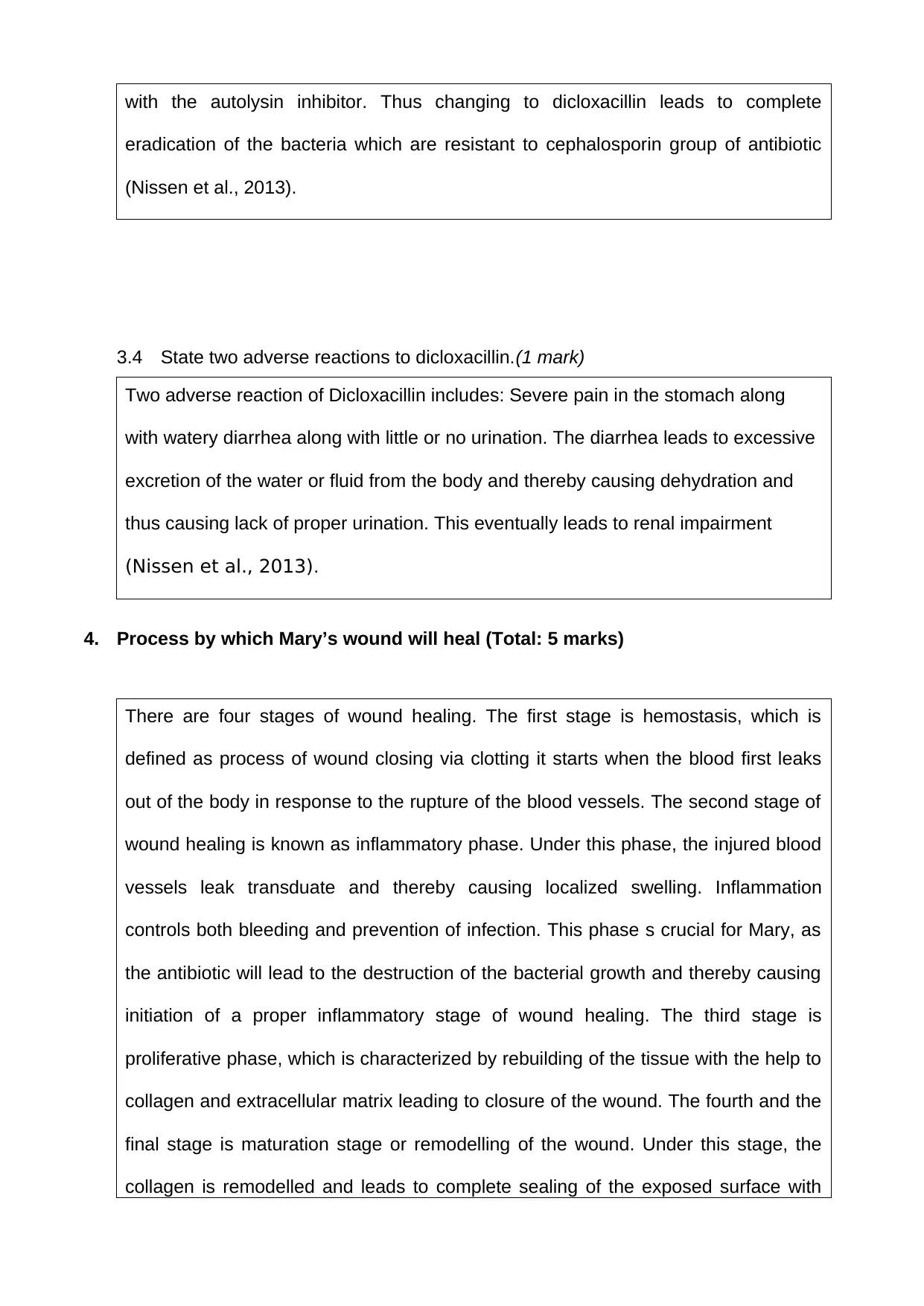
with the autolysin inhibitor. Thus changing to dicloxacillin leads to complete
eradication of the bacteria which are resistant to cephalosporin group of antibiotic
(Nissen et al., 2013).
3.4 State two adverse reactions to dicloxacillin.(1 mark)
Two adverse reaction of Dicloxacillin includes: Severe pain in the stomach along
with watery diarrhea along with little or no urination. The diarrhea leads to excessive
excretion of the water or fluid from the body and thereby causing dehydration and
thus causing lack of proper urination. This eventually leads to renal impairment
(Nissen et al., 2013).
4. Process by which Mary’s wound will heal (Total: 5 marks)
There are four stages of wound healing. The first stage is hemostasis, which is
defined as process of wound closing via clotting it starts when the blood first leaks
out of the body in response to the rupture of the blood vessels. The second stage of
wound healing is known as inflammatory phase. Under this phase, the injured blood
vessels leak transduate and thereby causing localized swelling. Inflammation
controls both bleeding and prevention of infection. This phase s crucial for Mary, as
the antibiotic will lead to the destruction of the bacterial growth and thereby causing
initiation of a proper inflammatory stage of wound healing. The third stage is
proliferative phase, which is characterized by rebuilding of the tissue with the help to
collagen and extracellular matrix leading to closure of the wound. The fourth and the
final stage is maturation stage or remodelling of the wound. Under this stage, the
collagen is remodelled and leads to complete sealing of the exposed surface with
eradication of the bacteria which are resistant to cephalosporin group of antibiotic
(Nissen et al., 2013).
3.4 State two adverse reactions to dicloxacillin.(1 mark)
Two adverse reaction of Dicloxacillin includes: Severe pain in the stomach along
with watery diarrhea along with little or no urination. The diarrhea leads to excessive
excretion of the water or fluid from the body and thereby causing dehydration and
thus causing lack of proper urination. This eventually leads to renal impairment
(Nissen et al., 2013).
4. Process by which Mary’s wound will heal (Total: 5 marks)
There are four stages of wound healing. The first stage is hemostasis, which is
defined as process of wound closing via clotting it starts when the blood first leaks
out of the body in response to the rupture of the blood vessels. The second stage of
wound healing is known as inflammatory phase. Under this phase, the injured blood
vessels leak transduate and thereby causing localized swelling. Inflammation
controls both bleeding and prevention of infection. This phase s crucial for Mary, as
the antibiotic will lead to the destruction of the bacterial growth and thereby causing
initiation of a proper inflammatory stage of wound healing. The third stage is
proliferative phase, which is characterized by rebuilding of the tissue with the help to
collagen and extracellular matrix leading to closure of the wound. The fourth and the
final stage is maturation stage or remodelling of the wound. Under this stage, the
collagen is remodelled and leads to complete sealing of the exposed surface with

the fresh set of tissues (Knottenbelt, 2013; Marieb & Hoehn, 2016).
⊘ This is a preview!⊘
Do you want full access?
Subscribe today to unlock all pages.

Trusted by 1+ million students worldwide
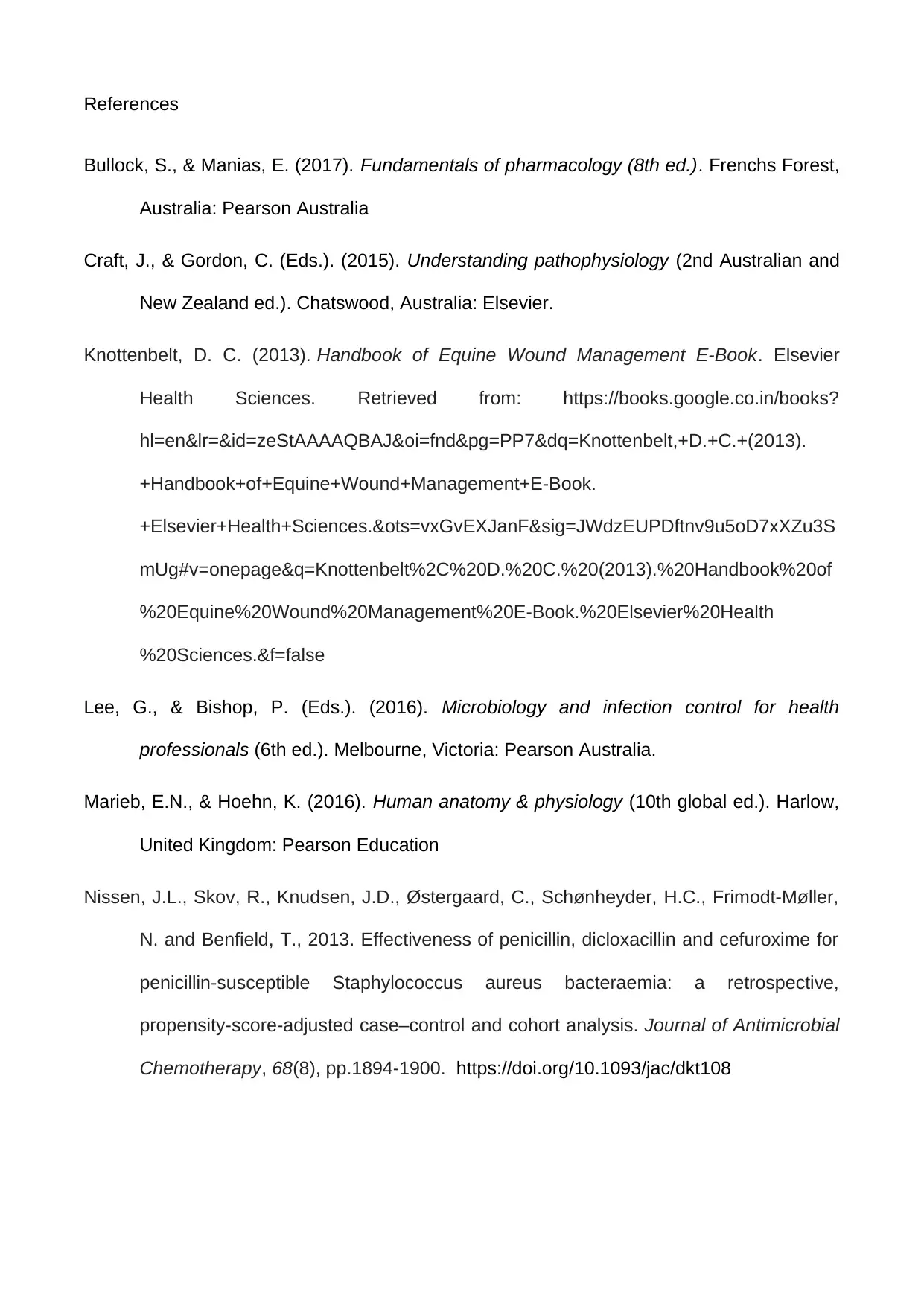
References
Bullock, S., & Manias, E. (2017). Fundamentals of pharmacology (8th ed.). Frenchs Forest,
Australia: Pearson Australia
Craft, J., & Gordon, C. (Eds.). (2015). Understanding pathophysiology (2nd Australian and
New Zealand ed.). Chatswood, Australia: Elsevier.
Knottenbelt, D. C. (2013). Handbook of Equine Wound Management E-Book. Elsevier
Health Sciences. Retrieved from: https://books.google.co.in/books?
hl=en&lr=&id=zeStAAAAQBAJ&oi=fnd&pg=PP7&dq=Knottenbelt,+D.+C.+(2013).
+Handbook+of+Equine+Wound+Management+E-Book.
+Elsevier+Health+Sciences.&ots=vxGvEXJanF&sig=JWdzEUPDftnv9u5oD7xXZu3S
mUg#v=onepage&q=Knottenbelt%2C%20D.%20C.%20(2013).%20Handbook%20of
%20Equine%20Wound%20Management%20E-Book.%20Elsevier%20Health
%20Sciences.&f=false
Lee, G., & Bishop, P. (Eds.). (2016). Microbiology and infection control for health
professionals (6th ed.). Melbourne, Victoria: Pearson Australia.
Marieb, E.N., & Hoehn, K. (2016). Human anatomy & physiology (10th global ed.). Harlow,
United Kingdom: Pearson Education
Nissen, J.L., Skov, R., Knudsen, J.D., Østergaard, C., Schønheyder, H.C., Frimodt-Møller,
N. and Benfield, T., 2013. Effectiveness of penicillin, dicloxacillin and cefuroxime for
penicillin-susceptible Staphylococcus aureus bacteraemia: a retrospective,
propensity-score-adjusted case–control and cohort analysis. Journal of Antimicrobial
Chemotherapy, 68(8), pp.1894-1900. https://doi.org/10.1093/jac/dkt108
Bullock, S., & Manias, E. (2017). Fundamentals of pharmacology (8th ed.). Frenchs Forest,
Australia: Pearson Australia
Craft, J., & Gordon, C. (Eds.). (2015). Understanding pathophysiology (2nd Australian and
New Zealand ed.). Chatswood, Australia: Elsevier.
Knottenbelt, D. C. (2013). Handbook of Equine Wound Management E-Book. Elsevier
Health Sciences. Retrieved from: https://books.google.co.in/books?
hl=en&lr=&id=zeStAAAAQBAJ&oi=fnd&pg=PP7&dq=Knottenbelt,+D.+C.+(2013).
+Handbook+of+Equine+Wound+Management+E-Book.
+Elsevier+Health+Sciences.&ots=vxGvEXJanF&sig=JWdzEUPDftnv9u5oD7xXZu3S
mUg#v=onepage&q=Knottenbelt%2C%20D.%20C.%20(2013).%20Handbook%20of
%20Equine%20Wound%20Management%20E-Book.%20Elsevier%20Health
%20Sciences.&f=false
Lee, G., & Bishop, P. (Eds.). (2016). Microbiology and infection control for health
professionals (6th ed.). Melbourne, Victoria: Pearson Australia.
Marieb, E.N., & Hoehn, K. (2016). Human anatomy & physiology (10th global ed.). Harlow,
United Kingdom: Pearson Education
Nissen, J.L., Skov, R., Knudsen, J.D., Østergaard, C., Schønheyder, H.C., Frimodt-Møller,
N. and Benfield, T., 2013. Effectiveness of penicillin, dicloxacillin and cefuroxime for
penicillin-susceptible Staphylococcus aureus bacteraemia: a retrospective,
propensity-score-adjusted case–control and cohort analysis. Journal of Antimicrobial
Chemotherapy, 68(8), pp.1894-1900. https://doi.org/10.1093/jac/dkt108
1 out of 7
Related Documents
Your All-in-One AI-Powered Toolkit for Academic Success.
+13062052269
info@desklib.com
Available 24*7 on WhatsApp / Email
![[object Object]](/_next/static/media/star-bottom.7253800d.svg)
Unlock your academic potential
Copyright © 2020–2025 A2Z Services. All Rights Reserved. Developed and managed by ZUCOL.


